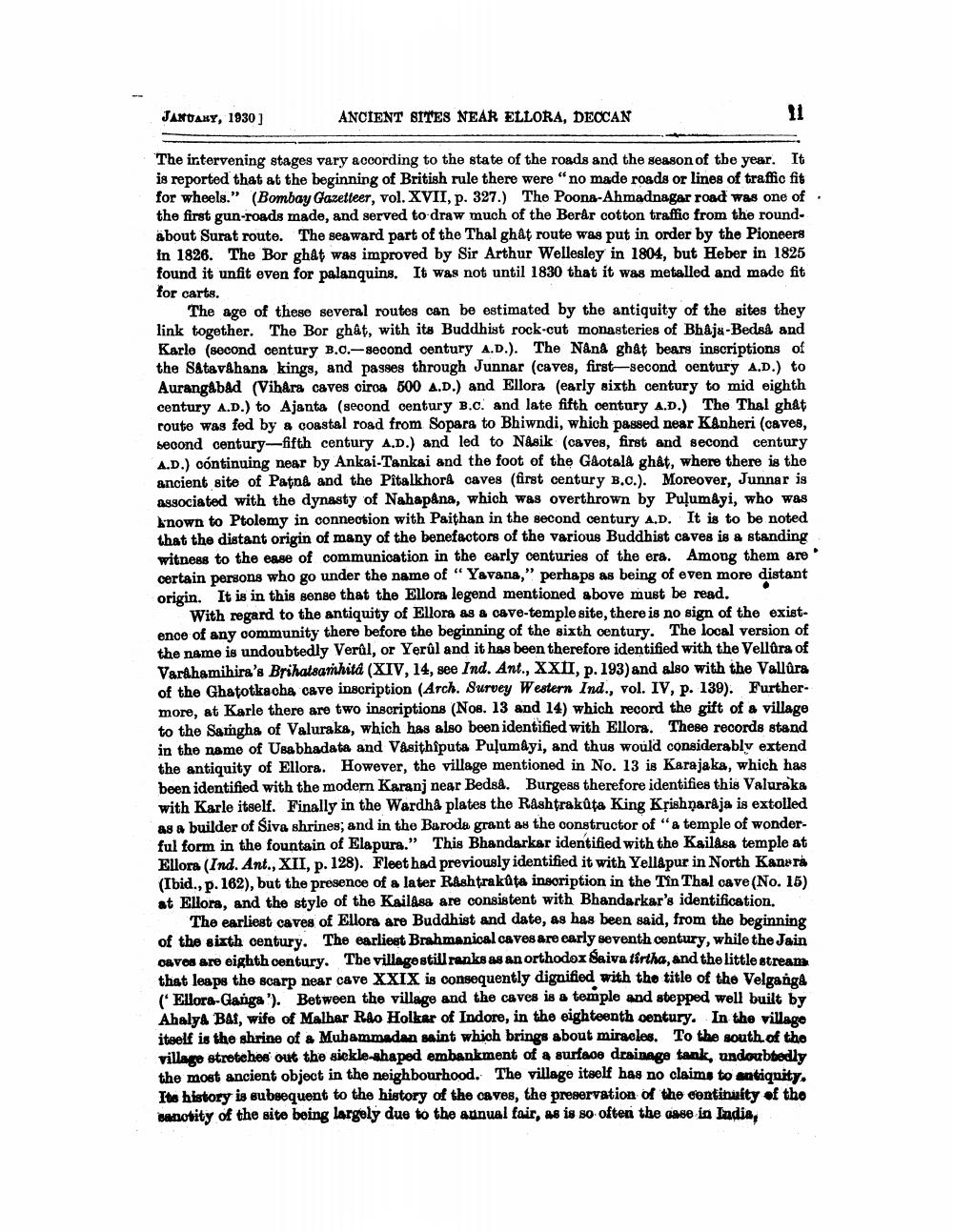________________
JANUARY, 1930 ]
ANCIENT SITES NEAR ELLORA, DEOCAN
The intervening stages vary according to the state of the roads and the season of the year. It is reported that at the beginning of British rule there were "no made roads or lines of traffic fit for wheels." (Bombay Gazetteer, vol. XVII, p. 327.) The Poona-Ahmadnagar road was one of the first gun-roads made, and served to draw much of the Berar cotton traffic from the round. about Surat route. The seaward part of the Thal ghat route was put in order by the Pioneers In 1826. The Bor ghat was improved by Sir Arthur Wellesley in 1804, but Heber in 1825 found it unfit even for palanquins. It was not until 1830 that it was metalled and made fit for carts.
The age of these several routes can be estimated by the antiquity of the sites they link together. The Bor ghat, with its Buddhist rock-cut monasteries of BhAju-Bedsa and Karlo (second century B.O.-second century A.D.). The Nana ghat bears inscriptions of the S&tav hana kings, and passes through Junnar (caves, first-second oentury A.D.) to Aurangabad (VihArs caves circa 500 A.D.) and Ellora (early sixth century to mid eighth century A.D.) to Ajanta (second century B.C. and late fifth oentury A.D.) The Thal gh&t route was fed by & coastal road from Sopara to Bhiwndi, which passed near K&nheri (caves, second century-fifth century A.D.) and led to Nasik (caves, first and second century A.D.) continuing near by Ankai-Tankai and the foot of the Gaotala ghåt, where there is the ancient site of Patna and the Pitalkhord caves (first century B.C.). Moreover, Junnar is associated with the dynasty of Nahapana, which was overthrown by Puļumáyi, who was known to Ptolemy in connection with Paithan in the second century A.D. It is to be noted that the distant origin of many of the benefactors of the various Buddhist caves is a standing witness to the case of communication in the early centuries of the era. Among them are certain persons who go under the name of “Yavana," perhaps as being of even more distant origin. It is in this sense that the Ellora legend mentioned above must be read.
With regard to the antiquity of Ellora as a cave-temple site, there is no sign of the existence of any community there before the beginning of the sixth century. The local version of the name is undoubtedly Verûl, or Yerûl and it has been therefore identified with the Vellûra of Varahamihira's Brihatsanhita (XIV, 14, see Ind. Ant., XXII, p. 193) and also with the Vallûra of the Ghatotkacba cave inscription (Arch. Survey Western Ind., vol. IV, p. 139). Furthermore, at Karle there are two inscriptions (Nos. 13 and 14) which record the gift of a village to the Sargha of Valuraka, which has also been identified with Ellora. These records stand in the name of Ubabhadata and Vasithîputa Puļumayi, and thus would considerably extend the antiquity of Ellora. However, the village mentioned in No. 13 is Karajaka, which has been identified with the modern Karanj near Bedså. Burgess therefore identifies this Valuraka with Karle itself. Finally in the Wardhå plates the Rashtrakūta King Krishnaraja is extolled as a builder of Siva shrines, and in the Baroda grant as the constructor of "a temple of wonderful form in the fountain of Elapura." This Bhandarkar identified with the Kailasa temple at Ellora (Ind. Ant., XII, p. 128). Fleet had previously identified it with Yellapur in North Kanera (Ibid., p. 162), but the presence of a later R&shtrakūta inscription in the Tin Thal cave(No. 15) at Ellora, and the style of the Kailasa are consistent with Bhandarkar's identification.
The earliest caves of Ellora are Buddhist and date, as has been said, from the beginning of the sixth century. The earliest Brahmanical caves are early seventh century, while the Jain 0&vos are eighth century. The village still ranks as an orthodox Saiva tirtha, and the little stream that leaps the scarp near cave XXIX is consequently dignified with the title of the Velgange (Ellora-Ganga'). Between the village and the caves is a temple and stepped well built by Ahalya BAT, wife of Malhar Rao Holkar of Indore, in the eighteenth century. In the village iteelf is the shrine of a Muhammadan saint which brings about miracles. To the south of the village stretches out the sickle-shaped embankment of a surface drainage tank, undoubtedly the most ancient object in the neighbourhood. The village itself has no claims to antiquity. Its history is subsequent to the history of the caves, the preservation of the continuity of the sanctity of the site being largely due to the annual fair, as is so often the case in Ladis,




